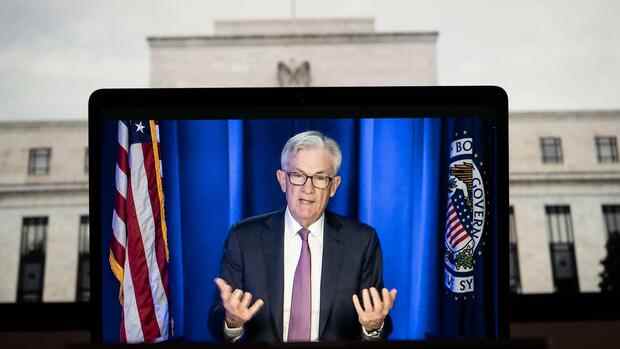Federal Reserve Chairman Jerome Powell had to change his strategy.
(Photo: IMAGO/Xinhua)
Frankfurt In the pandemic, Jerome Powell has positioned himself as an advocate for a strong job market. He delayed the turnaround in interest rates that many economists had demanded of him last year. He argued at the time that inflation could run a little hot. The Federal Reserve (Fed) chief wanted to make sure the jobs lost to Covid are bouncing back before raising interest rates and slowing the economy down a bit. He wanted to use monetary policy to help the lower and middle income groups, who were particularly hard hit by the pandemic.
Today it is clear: That was the wrong decision. Because inflation initially rose much faster than expected, partly due to the bottlenecks in the supply chains. Due to the consequences of the Ukraine war, prices rose further. With an unemployment rate of 3.8 percent, there is almost full employment again. But inflation, which has now shot up to 7.9 percent and could rise further, is now forcing the Fed to make an uncomfortable change in strategy.
The central bank announced the expected turnaround in interest rates on Wednesday and is now positioning itself as a tough fighter against inflation. Monetary politicians have signaled that interest rates could rise seven times this year.
What the Fed chairman didn’t say on Wednesday: The consequences of his late reversal in inflation will most likely lead to higher unemployment. In doing so, he would harm the very people he originally wanted to help the most. The question now is: how bad will it get? If the Fed raises interest rates too much and causes a recession, this will immediately have a noticeable impact on the labor market.
Top jobs of the day
Find the best jobs now and
be notified by email.
But the alternative is not exactly positive either. Harvard economist Larry Summers expects a phase of stagflation in which prices will remain high but the economy will only grow slowly. The former Treasury Secretary under US President Clinton expects both the inflation rate and the unemployment rate to level off at five percent in the coming years. And in the end, “stagflation often leads to recession,” as he pointed out in a guest post in the Washington Post on Wednesday.
Many Americans are already suffering from high prices, especially for gas, food and rent. Because even if the labor market is booming and wages are rising, prices are rising faster.
In the current situation, raising interest rates significantly and reducing the balance sheet total as planned is the only right way. But it will be painful. Powell’s hope: he wants to cool the economy and bring inflation under control, but not send the economy into recession. The central bankers were optimistic on Wednesday.
They assume that unemployment will continue to fall until the end of the year – to 3.5 percent and then remain at this level. This emerges from the economic projections, which were also published on Wednesday. That sounds good in theory, says Diane Swonk, chief economist at Grant Thornton. “But it has never been successful in comparable situations.”
More: To combat inflation, the Fed raises interest rates by 0.25 percentage points – and announces further steps. It’s the start of a risky mission.
